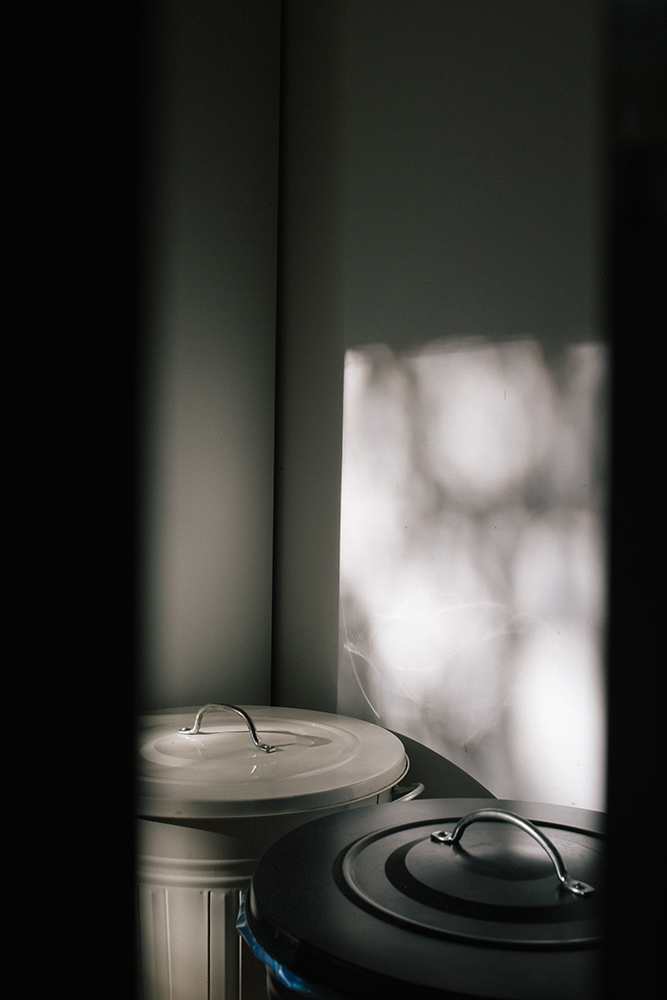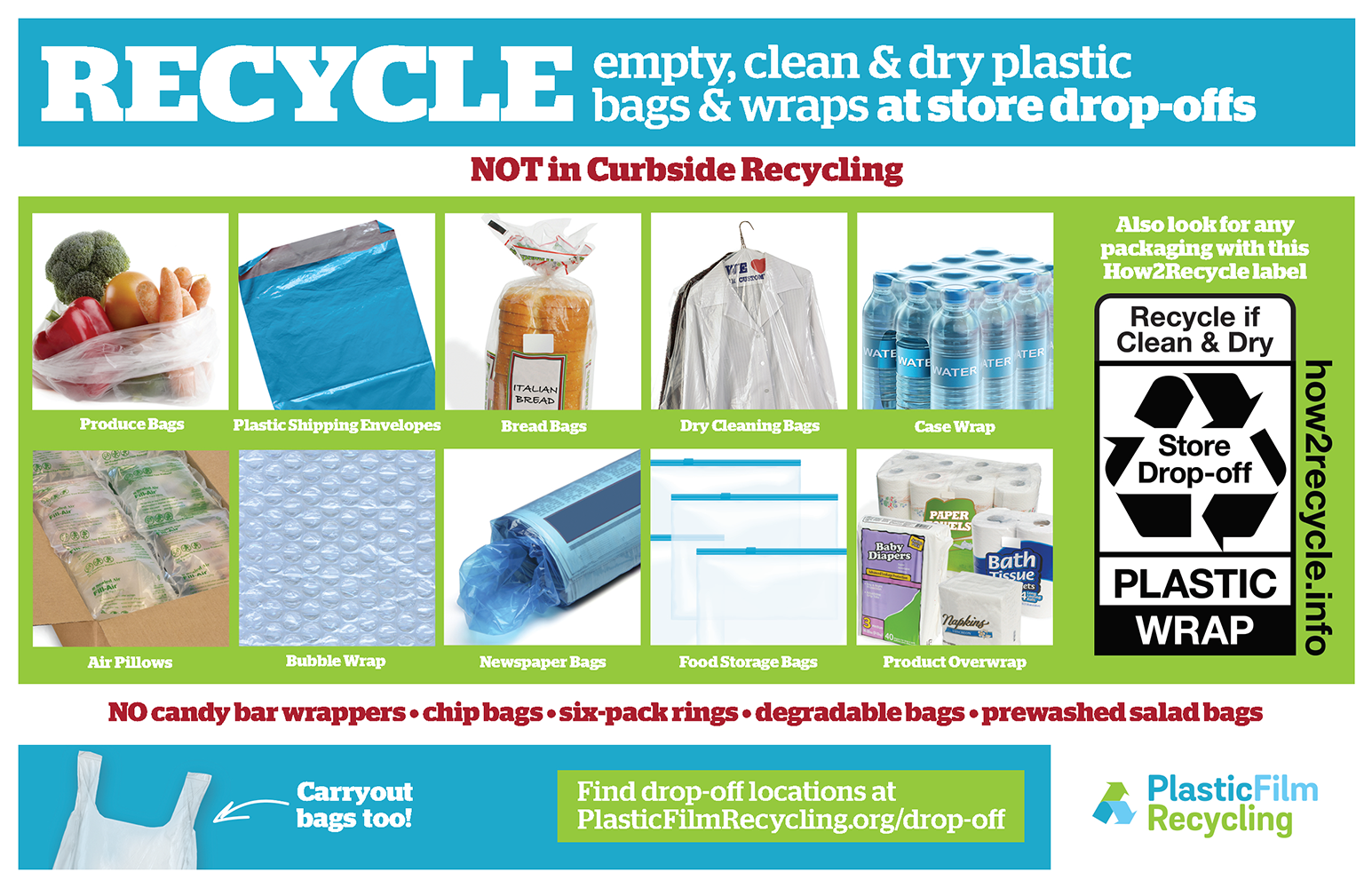


Depending on where you live, you may have seen people recycle plastic grocery bags. Over the past 5 years, grocery stores have been swapping out their plastic grocery bags for paper ones. Commonly, most stores charge you 5-10 cents per paper bag. However, as an incentive to bring your own bag, you won’t be charged, and may even receive a 10 cents discount at checkout.
Recycling stations can be found in most communities in the U.S. Many grocery stores have an area or bin designated for this purpose. But did you know that you can recycle beyond the plastic bag? Soft plastic film is recyclable too.
What is soft plastic film?:
Plastic film consists of produce bags, dry cleaning bags, the overwrap around newspapers, paper towels, toilet paper, and even bubble wrap and air pockets used for shipping purposes.
How to recycle it?:
The main difference between recycling jars, bottles, and other big recyclable items that you normally do at home is that you cannot place your soft plastic film in the same curbside recycling bins that you do at home. Instead, it must be taken to a drop off location held at some retail stores including most grocery stores. See here for a list of 18,000 different drop-off locations within the U.S. and Canada.
What is done with it?:
The majority of plastic film gets turned into composite lumber that are generally made up of two substances; sawdust and plastic bags. Composite lumber is a type of product that consists of various types of wood that are reclaimed and recycled along with the addition of plastic and different types of chemical compounds. Some common items that are made up of composite lumber are outdoor decks, wooden door frames, window frames, benches, and playground sets. Recycled plastic bags are also used to make post-consumer resin, which is then employed in the manufacturing of new plastic bags, crates, pipes, pallets, and containers.
Soft plastic film requirements:
All soft plastic film must be clean, dry, and have zero food residue on it. It must be soft, flexible polyethylene (PE) packaging such as grocery, bread bags, zip-top food storage bags, dry cleaning bags, deflated bubble wrap, and more. See below for the full list and references. Watch this video here for more information.

Acceptable:
1. Plastic bags
2. Produce bags
3. Plastic shipping envelopes
4. Bread bags
5. Dry cleaning bags
6. Case wrap
7. Air pillows (deflated)
8. Bubble wrap (deflated)
9. Newspaper bags
10. Food storage bags (zip-lock style of bags)
11. Product overwrap (paper towel overwrap, toilet paper overwrap, diaper overwrap)
Not Acceptable:
1. Candy bar wrappers
2. Chip bags
3. Six-pack rings
4. Degradable or compostable bags
5. Prewashed salad bags
6. Frozen food bags
Why is it important to recycle soft plastic film?:
We live in a world of convenience and though that has its perks, it also comes with a lot of negatives. Plastic bags are not biodegradable and are estimated to take up to 500 to 1,000 years to decompose, all while releasing gasses and chemicals into the world, which then makes its way into our water, soil, food, and ecosystem. Taking the extra couple minutes to separate and clean (if dirty) this type of plastic and drop if off monthly will severely impact our planet and oceans in a very positive and powerful way.
あなたが住んでいる場所によっては、人々がビニール袋をリサイクルするのを見たかもしれません。 過去5年間、食料品店はプラスチック製の食料品袋を紙製のものに交換していました。 一般的に、ほとんどの店舗では、紙袋あたり5〜10セントが請求されます。 ただし、自分のバッグを持参すれば、インセンティブとして精算時に10セントの割引を受けることさえできます。
リサイクルステーションは、米国のほとんどのコミュニティにあります。多くの食料品店にも指定されたエリアまたはビンが設置されています。 しかし、そんな中ビニール袋以外にもリサイクルできることを知っていましたか? 柔らかいプラスチックフィルムもリサイクル可能なのです。
軟質プラスチックフィルムとは何ですか?:
プラスチックフィルムは、農産物バッグ、ドライクリーニングバッグ、新聞紙、ペーパータオル、トイレットペーパー、さらには輸送目的で使用されるプチプチとエアポケットなどです。
リサイクル方法は?:
リサイクルジャーやボトルとその他の大きなリサイクル可能なアイテムの違いは、自宅付近のリサイクル用収集ボックスに、柔らかいプラスチックフィルムを入れられない事です。 代わりに、ほとんどの食料品店を含むいくつかの小売店に設けられた、専用の場所に持って行かなければなりません。 米国およびカナダ内の18,000の異なる収集場所のリストについては、こちらを参照してください。
それで何が行われますか?:
プラスチックフィルムの大部分は、一般に2つの物質で構成される複合材に変わります。 おがくずとビニール袋。 複合材は、プラスチックやさまざまな種類の化合物の添加とともに、再生およびリサイクルされるさまざまな種類の木材で構成される製品の一種です。 複合材で構成される一般的なアイテムには、屋外デッキ、木製ドアフレーム、窓フレーム、ベンチなどがあります。 リサイクルされたビニール袋は、消費後の樹脂の製造にも使用され、その後、新しいビニール袋、クレート、パイプ、パレット、および容器の製造に使用されます。
柔らかいプラスチックフィルム必要条件:
すべての柔らかいプラスチックフィルムは、清潔で乾燥し、食品の残留物がゼロでなければなりません。 食料品、パン袋、ジップトップ食品保存袋、ドライクリーニングバッグ、しぼんだプチプチなど、柔らかく柔軟なポリエチレン(PE)包装でなければなりません。 完全なリストついては、以下を参照してください。 詳細については、こちらのビデオご覧ください。
認められるもの:
1.ビニール袋
2.生鮮食品の袋
3.プラスチック封筒
4.パンの袋
5.ドライクリーニングバッグ
6.ケースラップ
7.空気枕(収縮)
8.プチプチ(収縮)
9.新聞バッグ
10.食品保存袋(ジップロック式の袋)
11.製品オーバーラップ(ペーパータオルオーバーラップ、トイレットペーパーオーバーラップ、おむつオーバーラップ)
認められないもの:
1.飴の包み紙
2.スナックの袋
3. 缶飲料のプラスチックリング
4.分解性または堆肥化可能なバッグ
5.洗浄済みサラダバッグ
6.冷凍食品バッグ
軟質プラスチックフィルムをリサイクルすることが重要な理由:
私たちは便利な世界に住んでおり、そこにはメリットもありますが、多くのデメリットもあります。 ビニール袋は生分解性ではなく、分解するのに500〜1,000年かかると推定されています。 ガスや化学物質を世界に放出し、それが私たちの水、土壌、食物、生態系に浸透します。 このタイプのプラスチックを分離してきれいにする(汚れている場合)ために数分余分に時間がかかり、毎月オフになって落ちると、非常にポジティブで強力な方法で地球と海洋に影響を与えます。